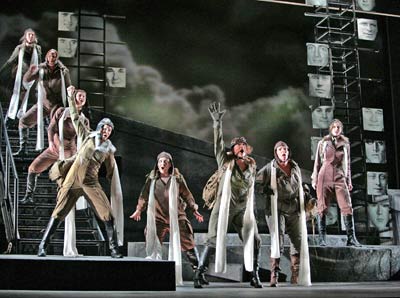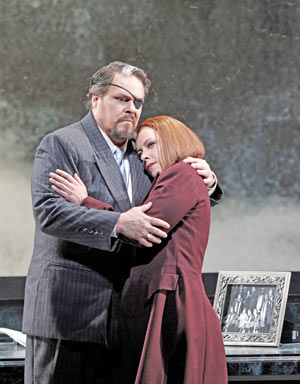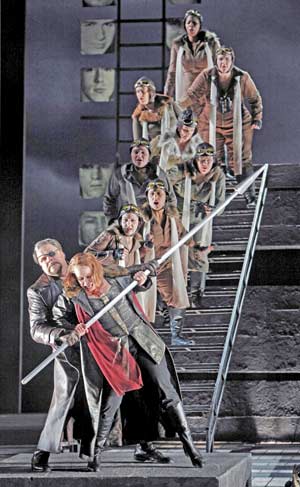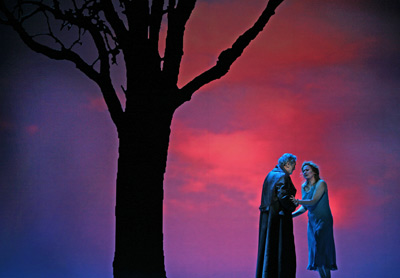San Francisco Splash’s¬†Opera nut (Philip G. Hodge) has outdone himself, sacrificing himself to five operas in six days with this being the last.¬† But it seems to agree with him.¬†
The¬†R I N G.¬† Is there any other one word that can provoke so much controversy among opera lovers?¬† There are some to whom Bayreuth is Mecca; and there are others who “would equally be willing for a dentist to be drilling as to ever let the¬†RING¬†into their life.”¬† Me, I’m somewhere in between.¬† If an evil genii forced me to choose between never again hearing¬†Wagner¬†and never again hearing¬†Verdi¬†or¬†Puccini, I would certainly choose to forswear Herr W.¬† But I’m very glad that I don’t¬†have to make that choice and that I can enjoy both the German and the Italians.

The thing is, I want everything in opera.¬† I want music, I want action, I want drama, tragedy, and/or comedy.¬† And¬†Wagner¬†does sometimes get a bit static.¬† I understand that in 1940 when¬†Helen Traubel¬†and¬†Lauritz Melchior¬†sang the love duet at the end of the last act of¬†Siegfried¬†they would plant their feet firmly to support their ample bodies and sing their hearts out for almost¬†half an hour.¬† A friend of mine in Minneapolis wrote me, “I saw Traubel and Melchior in¬†Tristan¬†when the¬†Met¬†was on tour.¬†¬†In the clinches, they would stand side by side since their prominent frontage prevented them from grappling.”
In 1990, on four successive evenings, PBS televised the then new¬†Met¬†production of the entire ring cycle with numerous stars including¬†James Morris¬†as Wotan and¬†Hildegarde Behrens¬†as Brťľnnhilde.¬† In addition to their superb voices, they showed lots of motion and emotion.¬† I not only enjoyed the entire cycle, but I made VCR tapes of all performances.¬† Alas, when I went to play them recently, time¬†had taken its toll on the tapes.¬† Half way through¬†Das Reingold¬†the tape tore and thoroughly jammed my VCR player.
More recently during the last two years I have seen a fascinating production of the first three operas from Valencia in HD at a local movie theater in Campbell.  The most striking difference between the Met and Valencia productions is in the sets.  The opening scene in Reingold takes place at the bottom of the Rhine.  The Met did a wonderful job of suggestion with coloring, lights, wavy things, moss-covered crags, and light ballet-type movements by the filmy-clad Rhine maidens.  Valencia eschewed realistic suggestion for surreal super-realism.  The stage contained three tanks filled with real water and swimsuit-clad Rhine maidens who frequently disappeared under water only to pop up singing in perfect harmony.
Two productions 20 years and an ocean apart.¬† Totally different and yet both with the same glorious music and with epic-style acting.¬† Isn’t it wonderful that I don’t have to choose?¬† I can see both.
But all of that was on television or HD.¬† Believe it or not, last night was the first time ever that I saw a Ring¬†opera LIVE!¬† But not, I hope, the last.¬† It was an exhilarating experience.¬†¬† I want to tell you about, but I don’t want to take the 3-1/2 hours (plus intermissions) that¬†Wagner¬†takes to tell it.¬† So I am going to assume that you know the story and the characters (if you don’t, you might want to pause here and read the excellent Wikipedia synopsis at¬†en.wikipedia.org/wiki/Die_Walkure) and concentrate on my impressions of this particular production.
My friend Elsa and I arrived a few minutes late for the pre-opera talk, but we heard most of it.¬† Got our tickets from the Press Room.¬† A bit disappointed to see that they were W1,3 – fourth row from the back, but on the aisle.¬† Great sight line, but the stage looked almost small.¬† Somehow looked different.¬† As my eyes became used to the dim light of the theatre,¬†I realized that I wasn’t seeing the curtain at all, but a motion picture of gently heaving grey seas.¬† Lights dim further.¬† Applause greets Maestro Donald Runicles¬†as he mounts to podium.¬† Absolute silence.¬† The overture begins softly.¬† The seas become more turbulent.¬† A great wave seems about to break, but instead of surf the seas are transformed into spiraling storm clouds.¬† These seem to thin and we see forest and we are through the clouds and the camera is speeding through the forest pointing in every direction.¬† Schwartzenwald – redwood forest – any forest.¬† The camera comes to a stop and through the picture we see that the familiar curtain is going up.¬† We have been viewing the picture on a scrim in front of the curtain.
Through the scrim we now see a small house in a clearing.  A one-room cottage made of finished lumber with glass windows and a screen door.  It could be any century, any continent.

In Hunding's house: Eva-Maria Westbroek (Sieglinde), Raymond Aceto (Hunding) and Christopher Ventris (Siegmund)
The scrim goes up and I guess that signifies the end of the overture and the beginning of Act I – the transition has been seamless.¬†¬† Sieglinde comes out of the house, sings a bit, goes back in.¬† Siegmund staggers in and falls exhaustedly to the ground.¬† Sieglinde comes out again.¬† They are mysteriously attracted to each other from the start although neither of them suspect that they are twins.¬† Hunding arrives, shows his brutality.¬† Finds out that Siegmund is the guy he’s been chasing.¬† But they are already in the house – another seamless scenery transition – and laws of hospitality restrain Hunding.¬† He promises safety for the night but they will fight to the death in the morning.¬† Orders Sieglinde to fix him a drink and wait for him “on the bed.”¬† What a difference one little word can make.¬† “on the bed” – an order to a sex slave – versus “in the bed” – a suggestion to a loving wife.
She fixes him a drink, all right, complete with a drug to knock him out for the night.  She returns to Siegfried and the two of them engage in some beautiful singing in which they learn all about each other and we learn the history of the ring up to now.  Another seamless change of scenery as the walls disappear and we are magically in a garden under a slowly rising full moon.  With passionate singing they fall hopelessly in love, Siegmund pulls the sword from the tree trunk, they run off into the woods.
It is all held together by¬†Wagner’s¬†sublime music.¬† From the opening chord of the overture to the lingering note of the lover’s embrace at the end of the act, the music is relentless.¬† Whether it’s the full orchestra, a solo instrument, a solo voice, a duet, or any combination thereof, the music is there.¬† It is inexorable.¬† I cannot escape.¬† I am totally a part of it.¬†¬† There is no respite.¬† No chance to pause and regroup.¬† The music moves effortlessly from on emotion to another – hope, sorrow, love, despair – wherever the music goes, I must go with it.
I mentioned above that Wagner is sometimes static.  That may be true Рthat is true Рof some productions.  But Director Francesca Zambello keeps things moving.  The actors are totally in tune with the music.  Slow?  Yes, when the music is slow to let a mood sink in.  But static? Never.
And so, after this first hour when the stage blacks out, it takes me a few seconds to return to reality and join in the applause.
Thee only three singers on stage during the entire act are¬†Hunding (bass¬†Raymond¬†Aceto),¬†¬† Sieglinde (soprano¬†Eva-Maria Westbrook), and Siegmund (tenor¬†Christopher Ventris).¬† In Act II, Scene 1 we meet the other three soloists: Wotan (baritone¬†Mark Delavan) the chief god, his wife Fricka (mezzo-soprano¬†Janina¬†Baechle)¬† the goddess of marriage vows, and Brťľnnhilde (soprano Nina Stemme), Wotan’s daughter by the earth goddess Erda.
What voices all six of those singers had.¬† Think of the challenge.¬† They had to reach over 3,000 people in the¬†War Memorial Opera House; they were competing with seventy-plus instruments in the orchestra; and they had to be true to¬†Wagner’s¬†music.¬† They succeeded beyond all reasonable expectations.¬† Not only that, but they were all consummate actors.¬† Even from row W their motions and body language were always in perfect agreement with the mood set by the words and the music.
Intermission’s over.¬† Time for Act II, Scene 1.¬† And what a scene.¬† Whereas the house and the forest in Act I could have been any time and place, the forestage is now modern big-business corporate world.¬† Wotan, in a business suit, is seated at an enormous conference table, apparently talking on the phone.¬† The entire back wall of this conference room consists of floor to roof windows looking out on a vast misty mountain range with Valhalla rising in the center of it.¬† Corny?¬† Incongruous?¬† Somehow, the answer is, “No.”¬† After all, Wotan was ruler of the world, and what corporation could be bigger?

Enter Brťľnnhilde, a sassy teenager.¬† Honestly.¬† I’ve no idea how old¬†Ms. Stemme¬†really is – if there were tell-tale wrinkles, I couldn’t see them from row W.¬† And there is no way that a teenager could sing as she sang.¬† But her clothing, her stance, her gestures all proclaim her as a tomboy schoolgirl.¬† Totally adores her father Wotan, but when¬†her stepmother Fricka sweeps into the room in full matronly evening-gown attire, it is obvious that the two women come from different planets.¬† There is no way that either of them can communicate with the other.
Big argument between Wotan and Fricka.¬† He plans for Siegmund to kill Hunding; she says, “No way.¬† Siegmund must die and you and that bastard daughter of¬†yours better see to it that he does.”¬† Back and forth they go until Wotan finally gives up. Brťľnnhilde hears the end of the argument in obvious disbelief.¬† There is a long and touching scene between father and daughter in which he unburdens his soul to her.¬† It’s not easy being top god.¬† I still have to make agreements and sign contracts, and then I have to keep them.
Act II, Scene 2.¬† There is an actual break here as the opaque scrim comes down for 60 seconds and then goes up on a sort of urban slum.¬† The two lovers are fleeing Hunding.¬† She’s pregnant and tires easily.¬† They rest. Brťľnnhilde appears to Siegmund and tells him, “Tough luck, fella, but you’re gonna die.¬† But don’t worry.¬† I’ll take you to Valhalla where you’ll be in Wotan’s army with lots of other heroes.”¬† When he finds out Sieglinde’s not included in the invitation, he balks.¬† “I won’t abandon my love and my unborn babe.¬† If I have to die anyhow, I’ll kill them first and then myself.” Brťľnnhilde is touched by this love and says in effect, “OK, OK.¬† I’ll save you.¬† But Daddy won’t like it.”¬† And sure enough.¬† She does and he doesn’t.¬† He shatters Siegmund’s magic sword with his mighty spear.¬† Hunding kills the defenseless hero and starts to crow about it.¬† Wotan contemptuously breaks his neck and takes off after the fleeing women.¬† Climactic end of Act II.
A welcome half hour to stretch the legs, and make a couple of notes.  Act III is on a mountain top.  Large circular rock at the center, of course with a sort of pathway up and around behind it.  A couple of vertical ladders ascending to above sight lines.  I assume they go all the way to Valhalla.  The audience gasps as three parachuting figures appear at upper right and descend diagonally to land at lower left singing their famous war cry.  The first three Valkyries have arrived dressed as American aviatrixes from World War II.  Each one carries a four-foot square photograph to symbolically represent the body of a slain warrior on his way to Valhalla.
One of the perks of being an official reviewer is that I get a press kit with, among other things, some tidbits of information not in the general program.¬† Thus, even though I’m too far from the stage to make out details, I know that these are photographs of actual men who died in the current wars in Afghanistan and Iraq, used with permission from their families – a nice touch to emphasize the universality of the story.
More Valkyries parachute in until eventually there are eight – all but Brťľnnhilde.¬† As Anna Russell says, “They are the noisiest bunch,” all singing at once, questioning each other but not waiting for an answer, interrupting each other.¬† As near as I could tell, all eight of them had wonderful voices.
Brťľnnhilde appears carrying Sieglinde.¬† Begs sisters to hide her from Wotan’s wrath.¬† “Hide you from Daddy?¬† No way!” say sisters.¬† But they do help Sieglinde escape and head¬† off alone to the forest where Wotan never comes.¬† There she will give birth to Siegfried who . .¬† . but that is another story –¬†Siegfried, to be precise.¬† Come back next summer when¬†SFOpera¬†will present the entire Ring cycle.

Wotan appears, fuming.¬† Calls Brťľnnhilde a traitor and threatens dire punishment.¬† Sisters sing, “have mercy.”¬† “What are you hanging around for,” sings Wotan.¬† “Get those heroes up to Valhalla PDQ or you’ll get the same.” Sisters leave.
Beautiful and touching final scene.¬† Wotan shows his internal conflict between love and duty and bemoans the fact that as a god he must choose duty. Brťľnnhilde must be punished by being stripped of her divinity, put into a magic sleep there on the mountain top, and married to the first man to find¬†her and kiss her awake.¬† (Remember, to these guys marriage is not the loving relationship that I had with my wife for oh so many years; it is a master-slave relationship and guess which one is the slave).
She rails for a bit but finally agrees that he has no choice.¬† She accepts her punishment and says she still loves him.¬† “But one last favor, please.¬† Don’t make me be married to a coward.¬† Do some magic so that only a hero can find and wake me.”¬†¬† Wotan agrees.¬† They have a final desperate embrace.¬† He kisses her eyes to induce the magic sleep, lays her down gently on the rock, and takes off his cloak to cover her.¬† He calls on the fire-god Logi for a ring of magic fire.¬† A flame leaps up to the left of the rock and rapidly runs back, across, and up the right side.¬† The scrim descends and shows leaping flames across the front to complete the circle.¬† The beautiful fire music swells and swells.¬† Wotan walks away sadly and slowly.¬† The flames rise higher and higher until . . . blackout.¬† Stunned silence, then thunderous applause as we, the audience, rise in a standing ovation.

The marathon opera is over.  My marathon opera week is over.  I enjoyed every minute of it.  Good night, all.
The Opera Nut
Sung in German with English supertitles
June 13th 1:00 p.m., June 19th 7:00p.m., June 22nd 7:00p.m., June 25th 7:00p.m., June 30th 7:00p.m.
San Francisco Opera
301 Van Ness Avenue
San Francisco, CA 94102
Box Office
Ticket and Patron Services
Telephone: (415) 864-3330
Fax: (415) 626-1729
Box Office Hours: Monday 10 am-5 pm, Tuesday-Friday 10 am-6 pm, during performance season also Saturday, 10 am-6 pm
SFOpera.com
Photo by Cory Weaver
P. S.¬† Another press kit tidbit.¬† Gas is fed into a perforated pipe around three quarters of the rock.¬† One end is ignited and the fire rapidly spreads the length of the pipe. Brťľnnhilde and Wotan are both wearing fireproof clothing in case of accident.¬†¬†Happily, there was no accident.
This review by Philip G Hodge appeared in sanfranciscosplash.com on June 2, 2010.


